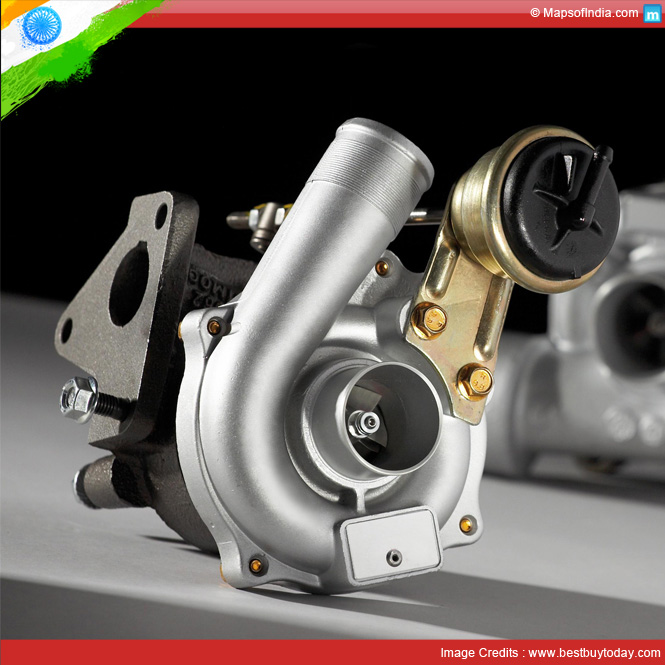When we’re working out, the most important thing to keep our focus on, is breathing. Cardiovascular exercises require of us to synchronise our body movement and breathing pattern making sure that we fill and empty our lungs as we move our arms and legs in near perfect rhythm. When a steady and fresh flow of oxygen is forced into our lungs and gets pumped into our system, it gives our body an added boost of freshness and energy. Improper supply causes tiredness, fatigue, and brings down the quality of our workout as the body and brain fight for oxygen, causing one of them to “max out” before the other, forcing us to break our exercise in between for rest.
Turbochargers, work on a similar principle. A turbocharger is a turbine driven mechanical device which works on the principle of forced induction. Forced induction is the technique of forcing compressed air into the combustion chamber of an otherwise naturally aspirated engine, in order to increase the power output and efficiency of the engine.
Every Turbocharger is made up of two main divisions, namely the turbine and the compressor. The turbine consists of the turbine wheel and housing. Turbines on average turbochargers achieve rotational speeds of over 150000 rpm. The turbine housing, guides the exhaust gas into the wheel. The pressure of the gas then turns the turbine wheel and flowing through it, the gas makes its way out of the housing through an exhaust outlet port. Like the turbine, the compressor is also made up of two major parts – the compressor wheel and the compressor housing. The compressor functions exactly opposite to the turbine – allowing the turbine attached to the compressor wheel with a forged shaft to run the wheel with it at a high velocity. The spinning motion of the wheel causes the compressor to draw in a fresh supply of cold air from the atmosphere into the housing and compress it. From within the housing, fresh air that was sucked in at low pressure is converted to high pressure and low velocity, through a process called diffusion, and pushed into the engine. With a forced supply of compressed air, the engine burns more fuel and produces much more power.
Often, the gas passing through the turbine achieves temperatures upto 760 degree C!
The first examples of forcing air into the combustion chamber come from the late 1880’s when Gottlieb Daimler patented the technique using a gear driven pump to achieve more power output from an IC engine. The turbocharger was however officially known to be invented by Swiss engineer Alfred Buchi who used a compressor driven by exhaust gases to force air into an internal combustion engine to increase its power output, and received a patent for the same in the year 1905. However, it took another 20 years for the turbo to achieve systematic functioning.
In a response to change in the throttle effort, the turbo changes the power output but with a slight delay. This time drop or slowed throttle response when accelerating, is called a turbo’s lag. This occurs because of the dependence on the exhaust system to generate the required boost. Inertia, internal friction and compressor running load are the primary contributors to turbocharger lag.
High intake air pressure means a higher temperature. The heat from the exhaust gases which spin the turbine further heats the intake air. Warm air has less density and also a lesser oxygen percentage which reduces the volumetric efficiency. Excessive intake air temperature leads to engine knock which is eventually destructive for engines. To overcome this problem, turbochargers employ a device called an intercooler, which brings down the temperature of the intake air in between the compression stage, allowing for higher density of compressed air and better combustion in engines. There are multiple intercooler designs, with fins, vanes and intricate tube paths for air to travel through and come out a t a much lower temperature and the inlet.
There are quite a few variations available in turbo designs and minor functioning all depending on the specific output being aimed at from a turbocharger.
A standard Turbocharger uses investment cast turbines both for intake and exhaust sections, and are tuned to provide high efficiency through a preset rpm range. The turbine blades are joint by a centre shaft that is suspended by a solid bearing which is cooled by engine oil.
Modern performance turbochargers use a ball bearing centre section instead of the solid bearing ones in order to allow the turbine blades free spinning motion and automatically decrease the low rpm turbo lag, and increase the turbo’s high rpm potential. They also produce less friction which allows the turbo heat up less and increases its life.
Two separate turbochargers, functioning in a sequence, or parallel to each other form a “twin turbo”. In the parallel configuration, both the turbochargers are fed half of the exhaust gas flow, causing twice the effort put in to creating higher quantities of compressed air to be pushed into the engine – with a greater power output and lower lag than standard turbos. In the sequential setup, one turbocharger runs at low speeds and the second runs on a prefixed engine speed/load. Sequential turbos reduce lag even further, but need a more sophisticated pipe setting to feed both the turbos.
Two stage twin-turbos have a smaller turbo working at low speeds and a larger one at greater speeds. They are connected in a series in order to multiply the boost pressure as it passes from the first turbo to the second. Smaller turbochargers create less lag than larger ones and hence it is preferred to use two small turbos than a single large one, popularly in engines bigger than 2500cc, V-blocks, and boxers.
Twin scroll turbochargers have two exhaust gas inlets and nozzles – the smaller, angled one for a quick throttle response and a larger, less angled one for achieving peak performance.





